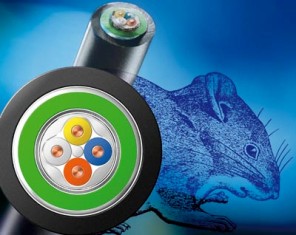Categories: Featured Articles » Sharing experience
Number of views: 34991
Comments on the article: 5
Protection of wires and cables from rodents
 If you plan to mount wiring in an apartment or a house, then you have a question about its protection from the negative effects of various factors. One of them is damage to cables and wires by rodents.
If you plan to mount wiring in an apartment or a house, then you have a question about its protection from the negative effects of various factors. One of them is damage to cables and wires by rodents.
This issue is especially relevant if it is necessary to lay electrical wiring lines under the floor, in the attic or in those places where the cable (wire) passes openly. Damage to cable lines that run in the ground is also possible. For example, those lines that power the wiring of various auxiliary buildings and structures located on the territory of a private house (bathhouse, garage, warehouse, etc.).
How can I protect the wiring line from rodents? In this case, it all depends on the specific situation. Consider several possible options.
The most optimal way to protect lines home wiring or apartments - this is laying them directly in the wall. That is, in this case, the cable or wire is under a layer of plaster or other finishing material. But in this case there is one caveat - not all electrical wiring lines can be laid directly in the wall. For example, electrical wiring lines supplying the lighting equipment of an apartment.
As a rule, for laying electrical wiring lines supplying the lighting devices of an apartment or house, holes are provided in the ceiling plates. If you lay a wire in this hole, then it is highly likely that the cable can be damaged by mice or rats that got into this channel. One way to solve this problem is to carefully seal the holes that lead into the channel of the ceiling plate.
It is also possible to cut new strobes on the ceiling for laying electrical wiring lines supplying lighting equipment. If the ceiling of the rooms of the apartment (house) is made of drywall, then you can lay the wiring lines directly under the drywall.

One of the ways to lay electrical wiring in the house is laying under the floor. If the wire is not protected, then it can be damaged by mice or rats. The most optimal way to protect electrical wiring lines laid in the floor is to pour them into a concrete screed. That is, you lay the necessary wiring lines, and then do the flooring. In this case, the wiring lines will be reliably protected from rodents.
If it is necessary to lay a cable in the ground, for example, to power the bathhouse or garage in the territory of a private lady, you should choose a cable that has an additional protective sheath - armor.
Armored cable reliably protects the cable from mechanical damage, including from mice, rats or moles. One of the most popular armored cables used for wiring is a cable of the type VBBSHV (with copper conductors) or AVBBSHV (with aluminum conductors).
It should be noted that the armored cable can be used in all cases when there is a need to protect cable lines from rodents. For example, laying lines in the attic, under the floor, etc.
What to do if a cable (wire) for wiring has already been purchased and there is a need to protect it from mice and rats? In this case, you can lay the cable in a metal hose or in a metal pipe.
There are also certain types of cables, the composition of the shell of which add special poisons that protect the cables from rodents. But in this case, there is a danger not only for mice, rats and moles, but also for humans, since hazardous substances containing in the cable sheath fall into the ground. Therefore, cables of this type are rarely used. The best option is to protect the cable with a metal sheath (armor).
See also at bgv.electricianexp.com
:

